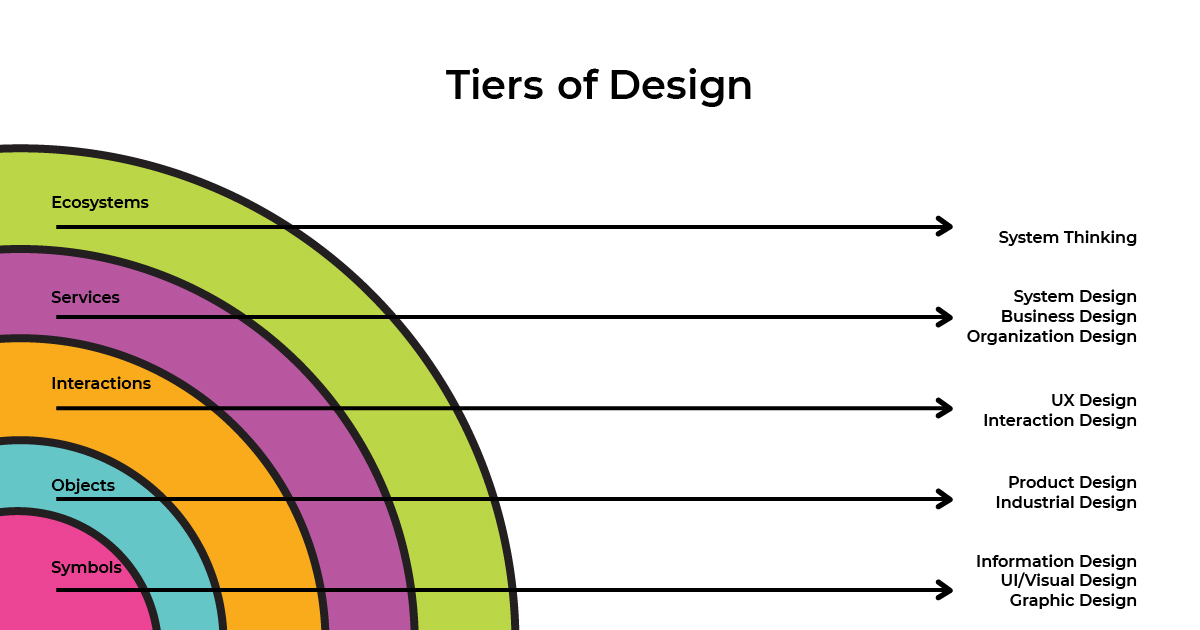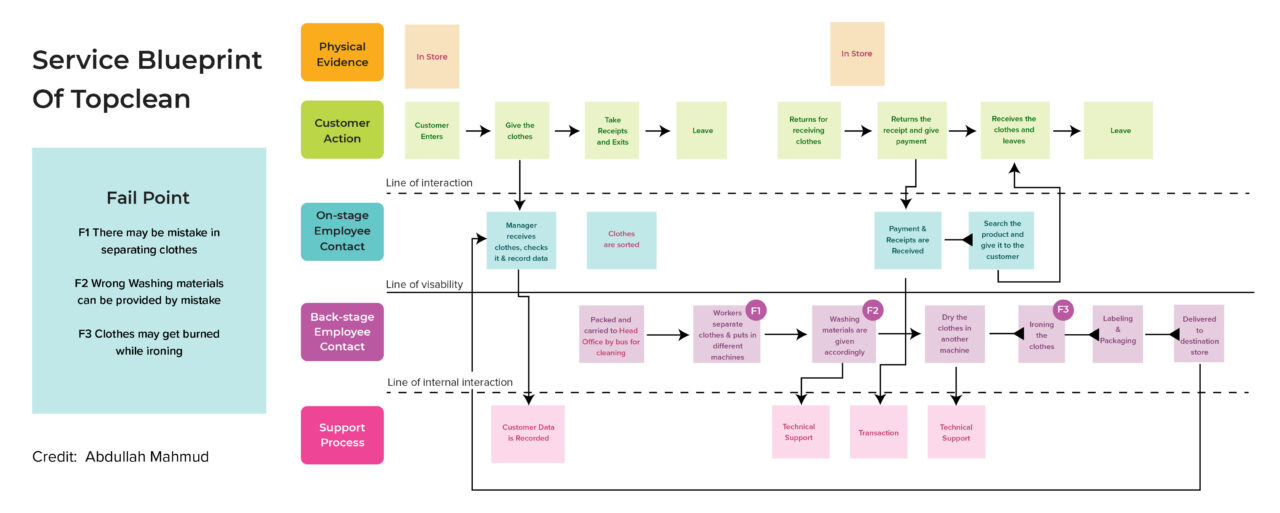Written By: Aday Sami-Orungbe
Since January 2024, Outwitly has delivered free monthly webinars to our vast community of designers and researchers, educating our audience on UX, service design, design research, and more. Today’s blog comes from one of our webinars, “Demystifying Service Design,” hosted by Outwitly’s very own Aday Sami-Orungbe, an incredibly talented Senior Service Designer. Before we dive into the blog based on her inspiring webinar, make sure you’re the first to know about our upcoming webinars by signing up for our newsletter!
Aday is a Nigerian-born Ontario-based service designer whose work meshes human-centred design practice with her extensive background in the strategic development of interactive experiences.
In this blog post, we’ll explore:
- What is Service Design? Problem-Solving Techniques and the Tiers of Design
- 5 Must-Have Skills for Service Designers
- Service Design in Action: A Service Blueprint Example
What is Service Design? Problem-Solving Techniques and the Tiers of Design
Countless careers exist within the umbrella of UX and HCD — so many that it can become confusing to wrap your head around! In a previous blog post, we defined HCD, UX, UI, design thinking, and more in detail. Check it out here.
Now, let’s take a look at the intricacies of service design and what makes it different from UX design.
What is Service Design
Simply put, design is problem-solving! Think about it: A fashion designer addresses the problems of clothing and the body, an interior designer addresses the problems of furnishing a room, and a service designer addresses problems related to human experiences. Sounds pretty straightforward, right? Well, the truth is that service design is quite a complex discipline. But don’t fret! We’re here to guide you through everything you need to know.
Service design is the design of systems that encompass users, service providers, business processes, and logistics. This work prioritizes and focuses on designing experiences that reach the user through many different touchpoints throughout their journey experiencing a product or service. Service design helps improve the customer or user experience, contributing to greater satisfaction and reducing the demand placed on an organization’s customer support team! Through service design, organizations can deeply understand their customers and the journey they embark on from start to finish.
A service designer discovers the customer’s or user’s pain points, finds new opportunities within a system and optimizes business processes. Through applying design research logic and systems thinking, service designers uncover everything that goes on behind the scenes. It helps to imagine service designers as spies, investigating and finding solutions for problems (big or small!) that you might not see as the user but make a big impact.
Problem-Solving Techniques in Service Design
As we mentioned, so much of what service designers do is problem-solve! Given the complex and multi-faceted nature of service design, a helpful approach is trying to understand the type of problem you’re dealing with. In Aday’s webinar, she shared how she finds it beneficial to conceptualize the problems she faces as a service designer into one of these three categories:
-
- Puzzles: These are service design challenges with one answer and one perfectly fitting end result. The problem typically has many different pieces, but there is an answer. You know what you must do: find all the pieces and fit them together. It’s not as easy as it sounds, but a clear solution exists!
- Mysteries: Mystery-style problems stand before you as several different winding paths you could go down. To get to an answer, you’ll have to take a trip down a few different paths and decide which is best. The best path may be the one that is the most efficient, most practical, or least expensive — regardless, it is important to ensure all members are in alignment on which direction to go in.
- Wicked Problems: With wicked problems, there should be an answer, but there is greater variability within that answer, or in other words, ‘results may vary.’ These types of problems pertain to social issues or widespread concerns that are nuanced and do not have a ‘one size fits all’ approach. Think: solving world hunger, for example.
Let’s zoom out a little and examine where service design lies among the many tiers of design.
The Tiers of Design: From Symbols to Services and Ecosystems
Another way we like to think of service design is as a graduate of the many other tiers of design. As designers, many of us will have the opportunity to shape and impact design at each level, which is cool if you ask us! As this visualization shows, UI and UX design tends to focus on the more in-depth user/customer experience of a single touchpoint. In contrast, Service Design is traditionally broader, covering all touchpoints within a customer journey. The further you expand outside the center circle, the more these different areas evolve in complexity and depth!
- Symbols: We start with the design of symbols. This area of design emphasizes visuals, whether that is UI design, graphic design, or information design. No matter what tier of design you work in, shape, form, and visuals will play a part in your role.
- Objects: Next, you graduate to objects, or in other words, things you can hold. In this tier, you’ll find product design and industrial design folks, as well as the application of mathematics to design practices.
- Interactions: This is the realm where design concepts are increasingly more abstract and less contextual. Here, UX and interaction designers create ‘flows’ or services that get users from point A to B. This tier focuses on human behaviours and considers how a user should interact with an interface or product and the steps needed to reach that goal.
- Services: This is where service design comes in! This tier is where thought processes concentrate more on systems in an organizational way. Your view expands to see problems on a much larger scale and understand all the various ‘tentacles’ of the system at hand. Services could be system design, business design, or organizational design.
- Ecosystems: Finally, ecosystems are outside of it all. This tier has a bird’ s-eye view of design and uses system thinking to comprehend large, complex projects and ideas. This area of design learns from real-life experiences and comprehensively examines all facets of a system and human nature.
All of the tiers of design are very important in their own right and don’t necessarily exist separately. Remember, design doesn’t happen in a vacuum! No matter their specialty, designers can always learn something from another tier.
Five Must-Have Skills for Service Designers
Zooming back in on service design, we’ve gathered the top 5 necessary and fundamental skills you’ll need when working as a service designer.
- Stakeholder management: Being skilled in managing stakeholder relationships is important, no matter your role in design or research, but is especially crucial as a service designer. As a service designer, your outlook must span past the user and must consider all moving parts within a system. This includes the stakeholders, which means knowing who is involved at what stage and how to deliver seamless experiences that satisfy and connect the dots between people, projects, goals, and internal teams. At Outwitly, we like to “map” out our internal stakeholders. We account for all the decision-makers, subject matter experts, potential advisors, and supporters (aka, champions!) from within the organization and work with our design team to figure out where, when, and how we will engage them in our project work. In fact, we build them right into our project plans!
- Visualization: Although not every designer is skilled in drawing or sketching, they must be skilled in visualizing complex, large, and abstract ideas. A large responsibility of a service designer is translating these fuzzy concepts and systems into something understandable and digestible for someone who doesn’t have a design background. Visualizing and inserting all the moving pieces into a service blueprint is extremely valuable. We’ve even provided you with an example later in this blog!
- Macro and Micro Thinking: Service designers have some of the best eyes in the industry. They are fantastic at zooming out and seeing everything at a glance, but can also zoom in on the most micro details in a system. For example, when building an app, service designers can hone in on the meticulous details of an interface but can also see everything existing in the context of that app. They must use both their detailed and contextual knowledge to move forward in their design process.
- Building the Cake (AKA, the Service) Slice by Slide, Not Layer by Layer: Now, you might be wondering, what does baking have to do with service design? During Aday’s webinar, she gave this incredible example of building MVPs (minimum viable products) piece by piece rather than layer by layer. Eventually, you build enough slices (MVPs) to create a whole cake. As a service designer, you need to be able to see a product end to end in slices, knowing when a product can work without certain features or enhancements. In service design, we like to prioritize building things modularly, in full, as a minimum viable product. This standalone functional aspect works properly on its own and has everything you need. This way, if one part of a service falls, it doesn’t take down everything around it on its way down. Plus, if one day, that piece of the service is no longer serving its users or working how it needs to, a service designer can easily remove and replace it.
- Being a Negotiator and Stabilizer: When designing a service, numerous needs arise from various directions, often leading to conflicting demands. Service designers must navigate this friction and negotiate between what the user may want, what the stakeholders may want, and what is possible. Sometimes, what a user wants from a service will negatively affect the team behind the scenes. Trade-offs will be required, and service designers must be skilled at finding a balance that satisfies all parties.
Service Design in Action: A Service Blueprint Example
In typical Outwitly fashion, we wouldn’t leave you without a tangible example to help you better understand how service design exists in the real world! This Service Blueprint of Topclean by Abdullah Mahmud helps show the layers and steps behind a typical dry-cleaning service.
Service Blueprints focus on how an organization supports the customer journey, keeping customers, staff, and other key players at the forefront. Blueprints depict the business’s processes and operations that occur within the front-stage (customer-facing), back-stage (internal) and behind-the-scenes!
Service blueprints like the one above are extremely valuable resources as they visualize how different components and interactions are interconnected. They also act as communication tools for informing stakeholders. Creating an easy-to-follow, clear blueprint can prompt discussions with stakeholders on areas that need improvement and identify where we can maximize customer engagement and satisfaction.
This blueprint structures the process in a way that considers all key players in a system and even divides the level of visibility using three horizontal lines. These lines, the line of interaction, line of visibility, and line of internal interaction, ensure an in-depth understanding of the entire service and can help categorize and divide responsibilities for improving a service. Another key aspect of this blueprint is the fail points. These fail points are the areas of high risk or areas that may require backup plans. For example, fail point three highlights an area where the dry-cleaning business could implement a compensation strategy if clothes were burnt or damaged.
For more on service blueprints, stay tuned for a future blog post where we’ll conduct a deep dive into the entire process of creating them. In the meantime, grab your free copy of our Guide to Customer Journey Maps vs. Service Blueprints!
We hope you leave today with a more robust understanding of service design and a better idea of how it truly exists everywhere in our day-to-day lives.
If you’d like to continue learning from esteemed UX professionals, sign up for our newsletter to stay informed about our upcoming webinars and receive valuable, never-spammy UX, service design, and HCD content straight to your inbox. Happy learning!








